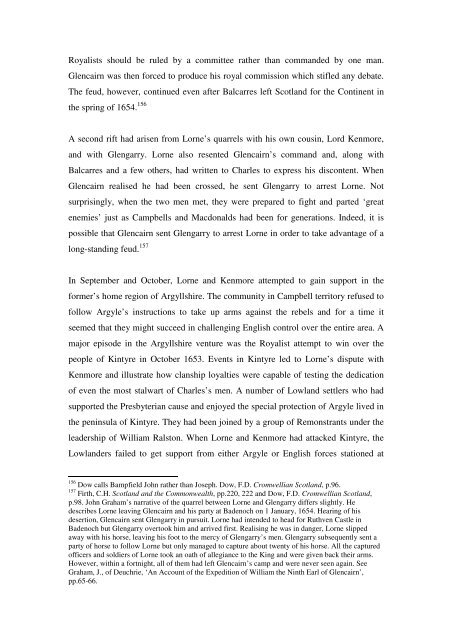The Glencairn Uprising, 1653-54 Helen Baker Department of ...
The Glencairn Uprising, 1653-54 Helen Baker Department of ...
The Glencairn Uprising, 1653-54 Helen Baker Department of ...
You also want an ePaper? Increase the reach of your titles
YUMPU automatically turns print PDFs into web optimized ePapers that Google loves.
Royalists should be ruled by a committee rather than commanded by one man.<br />
<strong>Glencairn</strong> was then forced to produce his royal commission which stifled any debate.<br />
<strong>The</strong> feud, however, continued even after Balcarres left Scotland for the Continent in<br />
the spring <strong>of</strong> 16<strong>54</strong>. 156<br />
A second rift had arisen from Lorne’s quarrels with his own cousin, Lord Kenmore,<br />
and with Glengarry. Lorne also resented <strong>Glencairn</strong>’s command and, along with<br />
Balcarres and a few others, had written to Charles to express his discontent. When<br />
<strong>Glencairn</strong> realised he had been crossed, he sent Glengarry to arrest Lorne. Not<br />
surprisingly, when the two men met, they were prepared to fight and parted ‘great<br />
enemies’ just as Campbells and Macdonalds had been for generations. Indeed, it is<br />
possible that <strong>Glencairn</strong> sent Glengarry to arrest Lorne in order to take advantage <strong>of</strong> a<br />
long-standing feud. 157<br />
In September and October, Lorne and Kenmore attempted to gain support in the<br />
former’s home region <strong>of</strong> Argyllshire. <strong>The</strong> community in Campbell territory refused to<br />
follow Argyle’s instructions to take up arms against the rebels and for a time it<br />
seemed that they might succeed in challenging English control over the entire area. A<br />
major episode in the Argyllshire venture was the Royalist attempt to win over the<br />
people <strong>of</strong> Kintyre in October <strong>1653</strong>. Events in Kintyre led to Lorne’s dispute with<br />
Kenmore and illustrate how clanship loyalties were capable <strong>of</strong> testing the dedication<br />
<strong>of</strong> even the most stalwart <strong>of</strong> Charles’s men. A number <strong>of</strong> Lowland settlers who had<br />
supported the Presbyterian cause and enjoyed the special protection <strong>of</strong> Argyle lived in<br />
the peninsula <strong>of</strong> Kintyre. <strong>The</strong>y had been joined by a group <strong>of</strong> Remonstrants under the<br />
leadership <strong>of</strong> William Ralston. When Lorne and Kenmore had attacked Kintyre, the<br />
Lowlanders failed to get support from either Argyle or English forces stationed at<br />
156 Dow calls Bampfield John rather than Joseph. Dow, F.D. Cromwellian Scotland, p.96.<br />
157 Firth, C.H. Scotland and the Commonwealth, pp.220, 222 and Dow, F.D. Cromwellian Scotland,<br />
p.98. John Graham’s narrative <strong>of</strong> the quarrel between Lorne and Glengarry differs slightly. He<br />
describes Lorne leaving <strong>Glencairn</strong> and his party at Badenoch on 1 January, 16<strong>54</strong>. Hearing <strong>of</strong> his<br />
desertion, <strong>Glencairn</strong> sent Glengarry in pursuit. Lorne had intended to head for Ruthven Castle in<br />
Badenoch but Glengarry overtook him and arrived first. Realising he was in danger, Lorne slipped<br />
away with his horse, leaving his foot to the mercy <strong>of</strong> Glengarry’s men. Glengarry subsequently sent a<br />
party <strong>of</strong> horse to follow Lorne but only managed to capture about twenty <strong>of</strong> his horse. All the captured<br />
<strong>of</strong>ficers and soldiers <strong>of</strong> Lorne took an oath <strong>of</strong> allegiance to the King and were given back their arms.<br />
However, within a fortnight, all <strong>of</strong> them had left <strong>Glencairn</strong>’s camp and were never seen again. See<br />
Graham, J., <strong>of</strong> Deuchrie, ‘An Account <strong>of</strong> the Expedition <strong>of</strong> William the Ninth Earl <strong>of</strong> <strong>Glencairn</strong>’,<br />
pp.65-66.
















